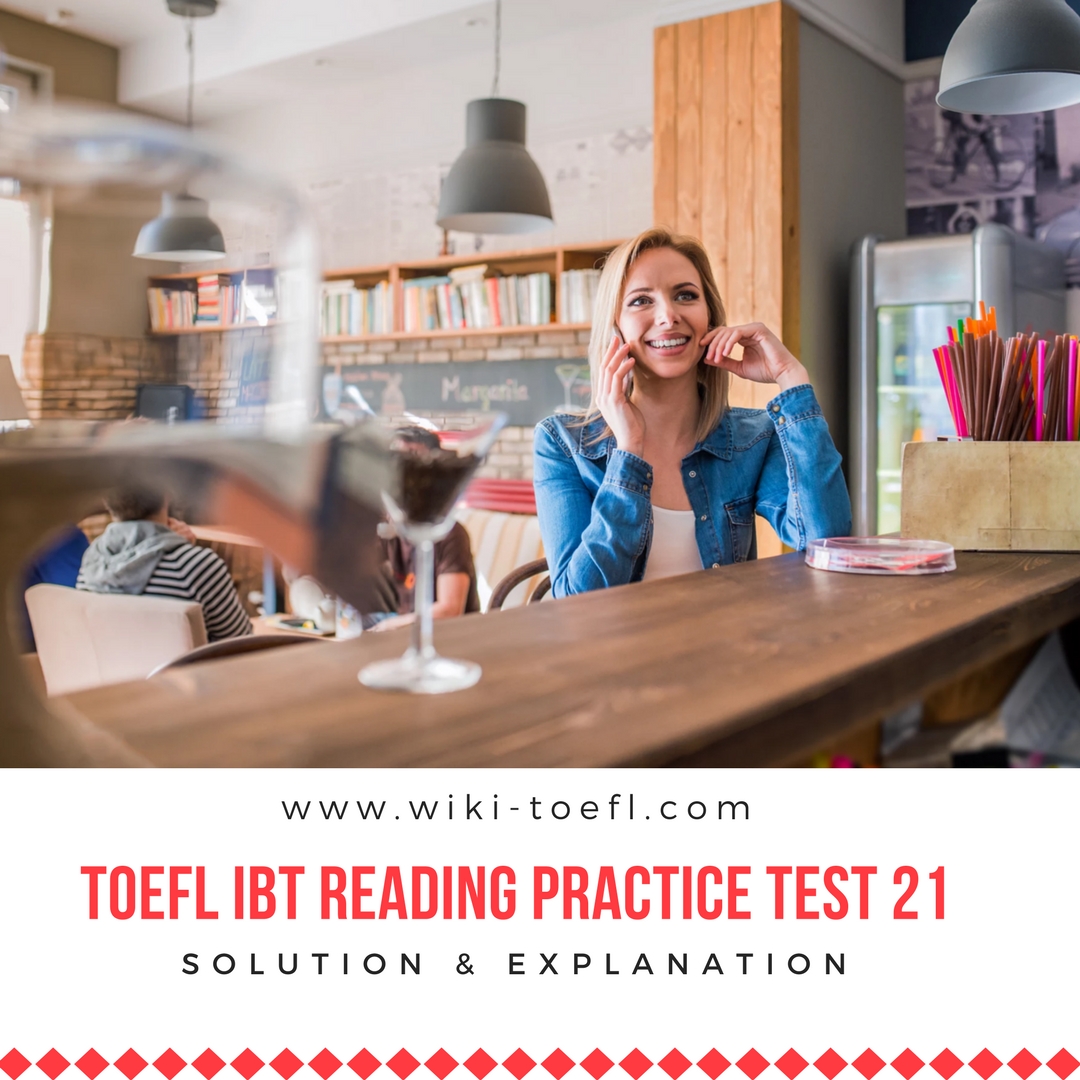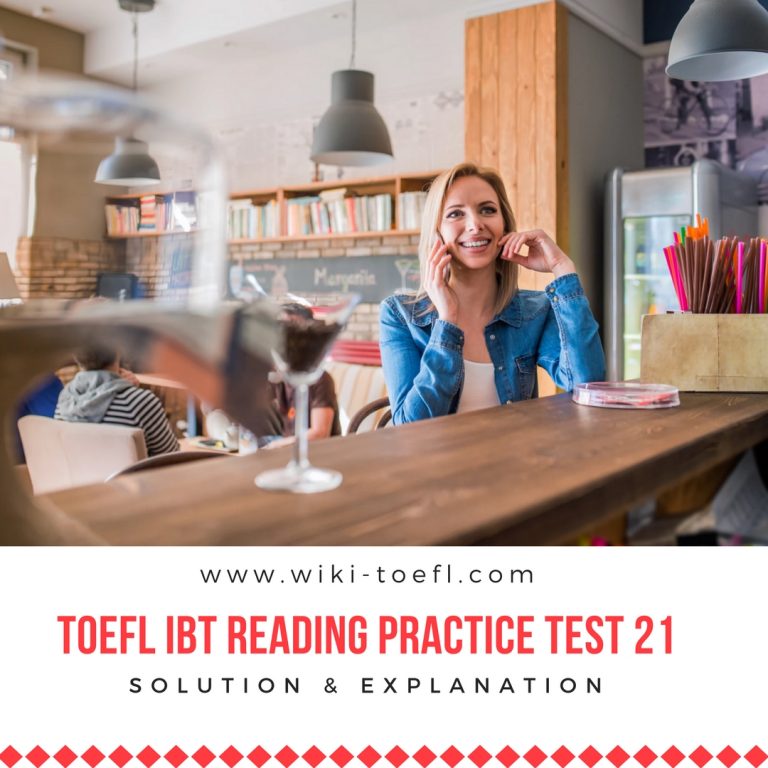Solution & Explanation for TOEFL iBT Reading Practice Test 21 from Delta’s Key to the Next Generation TOEFL Test – Six Practice Tests for the iBT by Nancy Gallagher
1. B The passage does not state that an unbroken prairie now exte nds from the western mountains to the eastern forest. All of the other answers are given: …temperatures can vary widely from very hot in summer to bitter cold in winter; The wetlands were soon surrounded by fluttering waves of grasses: shortgrass, mixed grass, and tall grass; An important feature of the northern Great Plains grasslands is the presence of millions of glacial depressions that are now small ponds known as prairie potholes. (1.2)
nds from the western mountains to the eastern forest. All of the other answers are given: …temperatures can vary widely from very hot in summer to bitter cold in winter; The wetlands were soon surrounded by fluttering waves of grasses: shortgrass, mixed grass, and tall grass; An important feature of the northern Great Plains grasslands is the presence of millions of glacial depressions that are now small ponds known as prairie potholes. (1.2)
2. B During the last century, large parts of the prairie have been converted to agricultural use. Clues: One hundred years ago, the Great Plains grasslands were one vast, unbroken prairie. Much of the prairie is now farmland…. (1.1)
3. D Alien means imported in this context. Clues:…virtually all the major native grasses have been replaced by alien species. Imported grasses have replaced the original, native grasses. (1.4)
4. B The prairie potholes owe their origins mainly to the glaciers that melted at the end of the last Ice Age. Clues: They were formed during the most recent Ice Age…. When the Ice Age ended around ago, the retreating glaciers created about 25 million depressions…. (1.1)
5. D Today these small wetlands still cover the prairies…is paraphrased in …the small ponds remain; …although much of the landscape… has been transformed to cropland and grassland for grazing is paraphrased in Even though a large portion of the prairies is used for crops and grazing…. (1.7)
6. A Dot means cover in this context. Clues: Today these small wetlands still cover the prairies…; …the seasonal wetlands that dot portions of Minnesota, Iowa…. (1.4)
7. B The author’s purpose is to emphasize the area’s value as a breeding ground for ducks. Clues: …serves as an important breeding area for more than 500 bird species, including large numbers of migrating shorebirds and waterfowl; Every spring, birds arrive in great numbers…to mate in the seasonal wetlands…; Prairie pothole country produces half of North America ‘s 35 to 40million ducks. …(1.6)
8. D A carbon sink removes carbon dioxide naturally from the atmosphere. Clue: …a vast carbon sink: a natural sponge that absorbs carbon dioxide emissions from cars, factories, and power plants.(1.1)
9. C The referent of this is something that scientists have termed “carbon sequestration.” The previous sentence states that carbon dioxide is captured naturally and stored in trees, soil, and plants. Logic tells you that this refers to the capture and storage of carbon dioxide in trees, soil, and plants. (1.3)
10. A You can infer that carbon sequestration in the prairie pothole region depends on the land not being disturbed by agriculture. Clues: …prairie potholes hold an average of 2.5 tons of carbon per acre per year when not being farmed;…if the entire pothole region in the United States and Canada were to stop being farmed, the region would store about 400 million tons of carbon over 10 years…. (1.5)
11. C Offset means counteract in this context. Clues: …the region would store about 400 million tons of carbon over 10 years—the equivalent of taking almost 4 million cars off the road. Thus, preserving the potholes could be a way to offset greenhouse gas emissions that are warming the planet. The prefix counter- = against; preserving the potholes would act against greenhouse gases such as carbon dioxide. (1.4)
12. A In the added sentence, Today is a time expression that logically follows One hundred years ago in the previous sentence. In the added sentence, however is a transition that shows contrast between the Great Plains grasslands were one vast, unbroken prairie in the previous sentence and the original grassland associations of plants and animals have been almost completely destroyed in the added sentence. (1.8)
13. B, C, E Key information: Much of the prairie is now farmland…dominated by monocultures of cereal grains; In areas given over to grazing lands…virtually all the major native grasses have been replaced by alien species; An important feature of the northern Great Plains grasslands is the presence of millions of glacial depressions that are now small ponds known as prairie potholes; …serves as an important breeding area for more than 300 bird species…; … the prairie pothole region is potentially a vast carbon sink…. Answer (A) is not mentioned; answers (D) and (F) are minor ideas. (1.9)
14. B The author makes the point that monarchs did not have real power but were symbols of national unity. Clues: …while monarchs remained symbols of national unity, real power had passed to constitutional assemblies. (1.1)
15. A Survived means remained in this context. Clues: At the start of the twentieth century, monarchs ruled over most of the world, but by the middle of the century, only a handful remained; …while monarchs remained symbols of national unity…; It lasted longer in the few small states…; the stem -vzv- = alive. (1.4)
16. B The referent of The term is something that applies to a broad group of states with a parliamentary or representative political tradition. The subject of the previous sentence is liberal democracy. Logic tells you that The term refers to liberal democracy. (1.3)
17. A The author’s purpose is to contrast two concepts of where political authority rests. In liberal democracies, political authority rests in the people acting through elected representatives. In people’s democracies, political authority rests in the Communist party. Clues: Liberal democracies differ from… in which the Communist party holds the ultimate authority. (1.6)
18. C Pattern means model in this context. Clues: …some form of liberal democracy…; …with the executive power vested in a cabinet responsible to the parliament…. The passage describes various forms or models of democracies: people’s democracies, parliamentary democracies, and presidential democracies. (1.4)
19. D The passage mentions a bill of rights stated in a constitution as a limit on state control. Clues: The liberal democratic state claimed the right to control every aspect of human life…except where limits on state control were directly stated in a bill of rights in a democratic constitution…. (1.1)
20. D Every democratic state changed during the twentieth century in the way that state activity expanded to promote the well being of the people. Clues: The expansion of state activity and extension of state services involved a new view of legislation and its role in society. The passing of laws came to be seen as a way to promote the well being of the people.(1.1)
21. C In these cases, some form of totalitarian dictatorship emerged… is paraphrased in Totalitarian dictatorships took over some democracies…;… replacing popular sovereignty with the total power of the state is paraphrased in … took over some democracies with the idea that the state, not the people, held all power. (1.7)
22. B The authority of the people through elected representatives is not a characteristic of authoritarian governments; it is a characteristic of liberal democracies. All of the other answers are given: …a system that prohibited parties opposed to the regime…; …a head of state or leader with exceptional powers…;… a bureaucratic administration that was in no way subject to popular control. (1.2)
23. A You can infer that the author believes there was a general movement away from monarchy toward democracy, with some cases of authoritarian rule. Clues: In most states where monarchical authority was removed, some form of liberal democracy took its place; The trend toward liberal democracy continued throughout the century, but at various times there was also a tendency toward a revival of authoritarian rule. (1.5)
24. D In the added sentence, for example is a transition that introduces the example of the British Parliament passing more laws in the first half of the twentieth century than in all its previous history. This example develops the idea that the number of new laws increased immensely, mentioned in the previous sentence. (1.8)
25. A, E Monarchy: …a monarch, whose right to rule is generally hereditary and lifelong; Monarchy survived as a form in Europe only where the king or queen functioned as the symbolic head of a parliamentary state….
B, F Liberal Democracy: …an elected executive is responsible to the will of the people as a whole; The doctrine that all of the people had effective authority, or sovereignty, became the basis for the functioning of democratic states. This doctrine of popular sovereignty….
D Dictatorship: …some form of totalitarian dictatorship emerged, replacing popular sovereignty with the total power of the state;
…a head of state or leader with exceptional powers, with a party to support him. Answers (C) and (G) are not mentioned. (1.10)
26. B The author’s purpose is to emphasize the close connection between smell and the brain. Clues:
Smell is the most direct of all the senses; The olfactory nerve, which manages the perception of smells, is essentially an extension of the brain; …a direct link from receptors at the top of the nose to the portion of the brain…. (1.6)
27. A Detects means notices in this context. Clues: ..receptors at the top of the nose…; …olfactory system detects certain airborne chemicals that enter the nose…; …chemical information…. The prefix de- = from. The olfactory system notices information from chemicals that enter the nose. (1.4)
28. D The color of the olfactory region at the upper end of each nostril shows the strength of the ability to smell. Clues: The shade of yellow indicates the strength of the sense of smell…; Animals have a very strong sense of smell, so their olfactory regions are dark yellow to reddish brown…. (1.1)
29. B Diffuse means flow in this context. Clues: When an odorous substance enters the nose…; Odor molecules diffuse into this region…; …odor molecules float up into the nasal cavity…. (1.4)
30. C When the cilia of the olfactory receptor cells absorb odor molecules, the olfactory nerve sends impulses to the brain. Clues: Odor molecules diffuse into this region and are absorbed by the cilia of the olfactory receptor cells; The receptor cells alert the olfactory nerve, which sends impulses to the brain s olfactory bulb, or smell center. (1.1)

